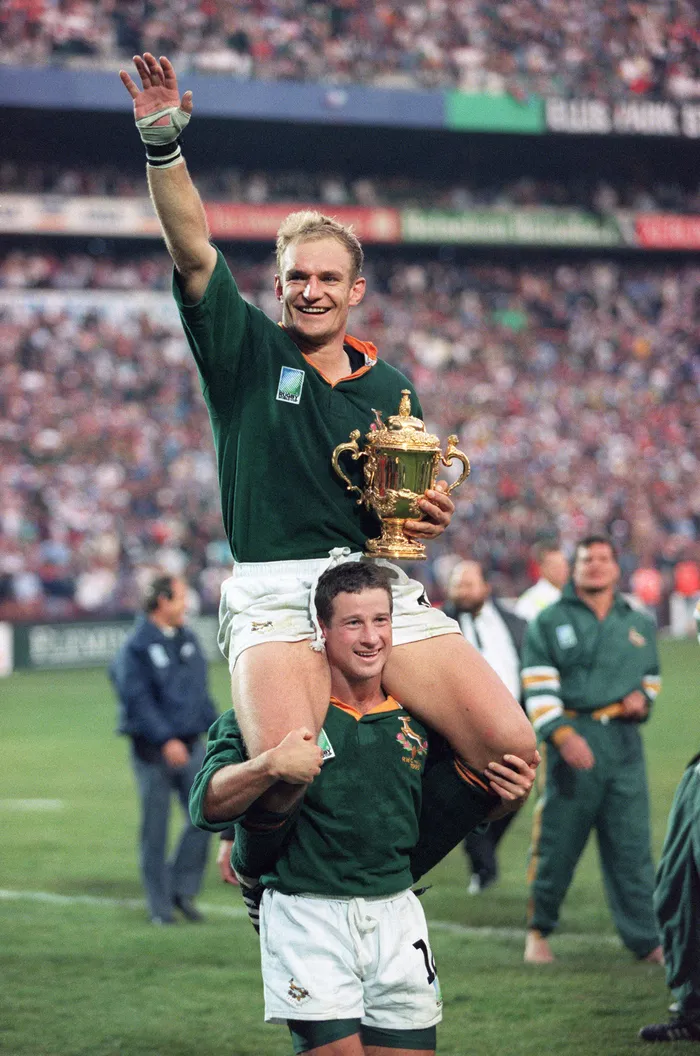Rugby World Cup 1995 I The Rainbow Nation's time to shine and not even Jonah Lomu could stop it
Rugby World Cup 1995

Victorous captain Francois Pienaar of teh 1995 Springboks led the country to our first Rugby World Cup by famously beating the All Blacks at Ellis Park On June 24. Photo: AFP
Image: AFP
When Sean Fitzpatrick woke up on the morning of the 1995 World Cup final, he parted the curtains of his hotel room in Sandton, Johannesburg, and his heart sank.
Outside was a small army of South African fans, brandishing placards along the lines of “This is our day, you are going to lose.”
On the way to the match at Ellis Park, there was the chilling sight of fans with “voodoo dolls” of the tournament’s star performer, the blockbusting All Black wing Jonah Lomu. The dolls had ropes around their necks.
Of course, these fans were extremists but that kind of behaviour summed up the passion that swept across South Africa.

Rugby World Cup 1995 | In retrospective
Image: Independent Media
Fitzpatrick said in his autobiography that he understood that New Zealand were up against way more that the Springbok rugby team. This was a country that had emerged from sporting isolation only two years before and had just ventured into democratic elections, a seismic shift for the African continent and one of the most significant developments of the 20th Century.
Fitzpatrick said that when he saw Nelson Mandela wearing Francois Pienaar’s No 6 jersey, his heart sank still further.
“It felt like we were being set up,” Fitzpatrick said. “The stars lined up for South Africa and we felt that that something bigger than rugby was happening in the country.”
The Kiwis were, nevertheless, the strong favourites for the final. While the Boks had doggedly fought their way through their pool games, and the quarter and semi-finals, the All Blacks had obliterated all in front of them.
Lomu was the juggernaut symbol of their team but they were way bigger and better than one man. Coached by Laurie Mains, the Kiwis had been building towards this Word Cup since losing their crown to Australia in 1991. They had won the inaugural World Cup in 1987, in New Zealand.
They had strong form going into the ’95 World Cup, momentum and a galaxy of stars. They had put almost 150 points past Japan in a pool game and smashed tournament favourites England in their semi-final.
Few thought the Boks had a chance but the atmosphere in Ellis Park that day leveled the playing field.
Before kick-off, helicopters circled the ground, displaying the flags of the 16 competing nations, but that was just a warm up. A jumbo jet was on its way and when it roared over the ground, Fitzpatrick’s dread sank into his boots.
The match was an agonising arm wrestle from first whistle to last. It could not have been any other way.
No tries were scored although Bok flank Ruben Kruger appeared to have got over the line and had there been TMOs in that era, he would have been awarded the points.
The All Blacks had more attacking intent but they found no way through the resolute Bok defence. Not even Lomu could breech the green line. When Bok scrumhalf Joost van der Westhuizen tackled Lomu at his ankles early in the game, the roar rattled the Ellis Park rafters.
The Boks led 9-6 at half-time thanks to three Joel Stransky penalties to two by opposite number Andrew Mehrtens.
The tension in the ground ratcheted up with every passing minute and the only points scored in the second half was a Mehrtens equaliser.
It remained 9-9 long into extra time, and South Africans tend to forget how close a Mehrtens drop goal came to winning the game. It wasn’t his day though, and as Fitzpatrick had felt in his bones, it was the Rainbow Nation’s time to shine, with Stransky kicking a drop goal that is forever etched in South African immortality.
Related Topics: